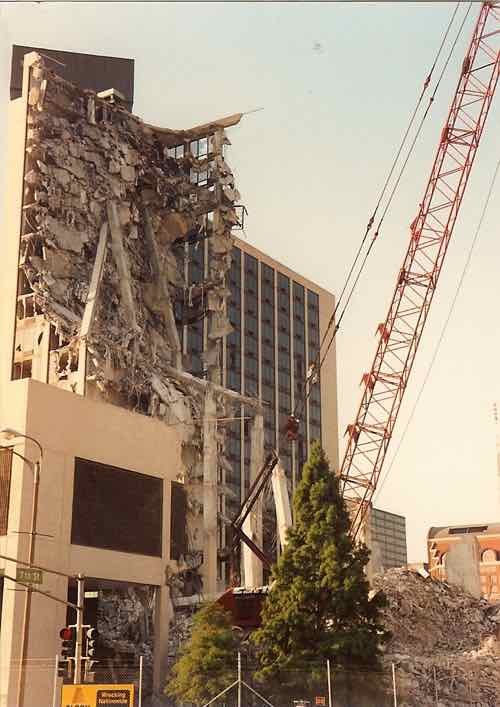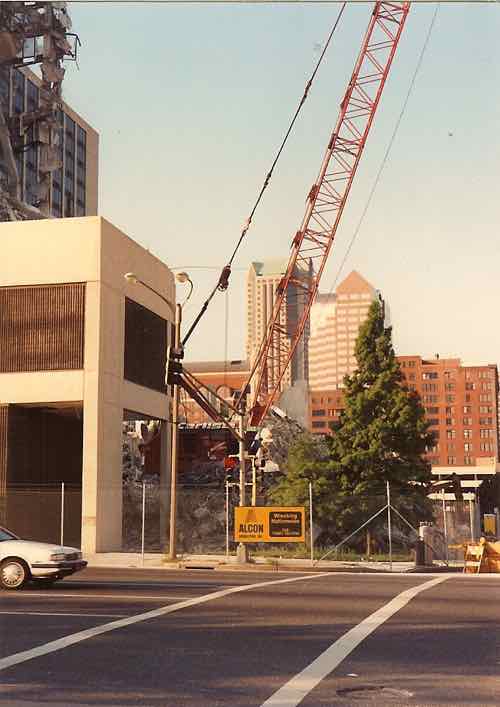Sheraton Convention Hotel Was Too Close to Convention Center
When St. Louis opened the Cervantes Convention Center in 1977 it had an adjacent convention hotel, a Sheraton, at 7th & Cole. Almost immediately talk of expanding the convention center was underway. The city had two options — go east of 7th Street or South of Delmar (renamed Convention Plaza). The convention center is now called America’s Center.
One problem with expanding the convention center to the East was the nearly new, 600+ room, Sheraton hotel that also opened in 1977.
From the St. Louis Post-Dispatch from Thursday, March 10, 1988:
If St. Louis follows through on its offer to buy and demolish the Sheraton St. Louis Hotel just east of the Cervantes Convention Center, the convention center could be left with a marketing nightmare, hotel industry insiders say. Razing the 614-room Sheraton to expand the convention center would leave the convention center, at least temporarily, without a hotel on the site that is large enough to handle visitors.
The city offered Monday to buy the Sheraton and other land east and south of the convention center to make way for a 120,000-square-foot expansion. Officials declined to disclose the amount of the offers. Hotel and real estate sources estimate that the Sheraton could be worth anywhere from $25 million to $40 million, but city officials said those estimates were high.
By May 1988 the city looked toward the South rather than the East:
There are several good reasons for the city to have changed directions on the Convention Center expansion and go southward to Washington Avenue instead of eastward across Seventh Street. A Convention Center fronting on Washington would remove an eyesore and contribute significantly to the revitalization of the street. It will thrust the center into downtown, whereas the eastward expansion would have left it on the periphery. Finally, it solves the problem of the Sheraton Hotel, east of the center. Under one scheme, the center was to be built around the hotel. Under another, the hotel was to be demolished. Neither approach was satisfactory.
The Convention Center is on Convention Plaza, better known as Delmar Boulevard, and is bounded by Seventh and Ninth streets. Under the latest expansion plan, Dillard’s parking garage and the Lennox Apartments would be spared but the other structures between Seventh and Ninth would go. The southward expansion would add 120,000 square feet, as would have the original plan. The cost, $72 million, will be about the same. The tourism industry is important to the economy of the region and the state. The expansion of the Convention Center will assure that the area will be able to attract large meetings that otherwise would go elsewhere [Source: St. Louis Post-Dispatch – Saturday, May 21, 1988]
The Sheraton hotel, just over a decade old, was spared demolition – for now at least.
Earlier in 1988 the football Cardinals announced plans to leave St. Louis for Arizona because St. Louis wouldn’t build them a stadium. The Cardinals had played football in Busch Stadium since it was built in 1966. I’m not sure where they played 1960-66. The team wanted a football stadium, not a shared baseball stadium.  The new stadium debate had already gone on for a couple of years before the Cardinals left. As soon as they announced they were packing their bags for Arizona the efforts to built a stadium and attract a new team gained speed. Soon the idea of expanding the convention center to the South with the stadium going East emerged.
From the St. Louis Post-Dispatch on Friday, December 14, 1990:
The Sheraton St. Louis hotel downtown is scheduled to close the first week of January [1991], idling about 300 workers and leaving the city without a major convention headquarters. Officials of the two unions that represent the employees were formally notified Thursday morning. The hotel lies in the path of the eastern expansion of the Cervantes Convention Center, a $250 million project that includes a domed stadium. The hotel will be torn down, but no date has been set for the demolition. Management of the Sheraton had expected to operate the hotel until construction of the stadium began. Until the last few days, the hotel was accepting reservations through 1991.
Late in 1987, city officials first publicly discussed an eastern expansion of the convention center. From that moment on, hotel industry sources say, the Sheraton has seen an erosion of bookings. It has always depended on group business, which is usually arranged two to four years in advance.
The best way to ruin a business is to threaten to take it away. Talk of razing a building a decade later. Smart. Taking out your convention hotel to expand your convention center, even smarter.
P-D on Tuesday, July 14, 1992:
As politicians smiled and sweated in Monday morning’s 89-degree heat, ground was broken for the $260 million stadium expansion of Cervantes Convention Center. The building, scheduled for completion by October 1995, will seat 70,000 for professional football. With 177,000 square feet of exhibit space on one level, it will accommodate events as large as national political conventions. During the hour-long ceremonial groundbreaking at Seventh Street and Convention Plaza, demolition crews began swinging a giant ”headache ball” at the old Sheraton Hotel, one block north. Each swipe at the 13-year-old hotel, which sits near the 50-yard-line of the stadium expansion, brought cheers. But the sturdily built hotel was slow to succumb to the headache ball.
It took a while to raze the nearly new structure. I recently found a couple of photos I had taken:


The expansion & dome were completed. St. Louis was not awarded an expansion team. Instead the Rams relocated from Los Angeles, California. It was not until 2003, over a dozen years later, that the Renaissance Grand & Suites opened to replace the loss of the Sheraton. Conventions expected by the expansion didn’t come due to the lack of a convention hotel. Brilliant!
Of course the Renaissance Grand convention hotel has had it’s own issues, from earlier this year:
The Renaissance Grand Hotel & Suites is set to be auctioned off Feb. 2 at the St. Louis Civil Courts Building, 11th and Market streets.
Since the hotel’s opening, it has repeatedly not generated enough revenue to cover its twice-yearly interest payments due on its $98 million debt load. New Orleans-based HRI Properties developed the hotel and is an owner. [Source: St. Louis convention center hotel headed for foreclosure, January 14, 2009]
Each decade the numbers get bigger and bigger. We had a convention hotel, then we didn’t and then we did again. The most jobs created through all this were for demolition companies and consultants.








